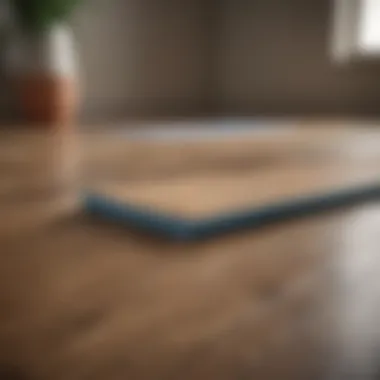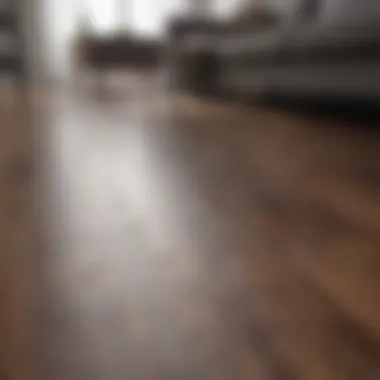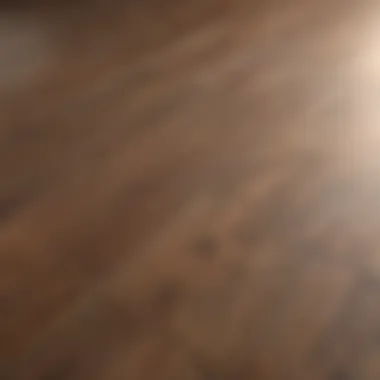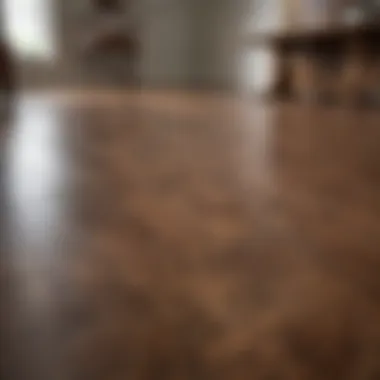Expert Tips for Caring for Laminate Flooring


Intro
Laminate flooring has gained undeniable popularity in contemporary homes. This material not only brings elegance but is also known for its durability and ease of use. However, like any other flooring, laminate requires the right care to keep it looking its best. If you want to maintain your laminate flooring effectively, it's crucial to understand its characteristics and the proper techniques that go with them.
Key Points to Discuss
- Understanding Laminate: What makes laminate unique?
- Cleaning Techniques: Effective methods to clean and preserve the floor.
- Protective Measures: Preventative steps to reduce wear and tear.
- Long-term Care Tips: Strategies for ongoing maintenance.
This comprehensive guide aims to inform readers about both the everyday and long-term considerations for keeping laminate flooring in top condition. By applying these principles, you can enhance both the function and beauty of your home, ensuring your investment remains fruitful for years to come.
Understanding Laminate Flooring
To maintain laminate flooring, one must first grasp the basic characteristics that set it apart from other flooring types. Not only does understanding laminate flooring equip homeowners with knowledge regarding care techniques, but it also highlights the unique features that contribute to its popularity.
Composition of Laminate Material
Laminate flooring is made up of several layers, each serving a specific purpose. Most commonly, it consists of a protective top layer, a design layer showcasing a pattern or image, a core layer providing stability, and finally, a backing layer that enhances durability. These layers work in tandem to mimic the look and feel of hardwood, stone, or ceramic, while delivering resilience against wear.
Advantages of Laminate Flooring
The attraction towards laminate flooring is hardly a mystery. Homeowners appreciate its cost-effectiveness, as it often comes at a fraction of the price compared to solid wood. This affordability, however, doesn't come at the expense of aesthetics. Laminate floors exude elegance that can elevate any room's ambiance.
On top of that, installation is typically easier with laminate. Many options feature a click-and-lock design, allowing DIY enthusiasts to tackle their flooring projects without the need for professional help. Additionally, laminate flooring is generally more resistant to scratching and staining than its wood counterparts. This quality makes it an interesting choice for families with pets or active children who tend to introduce additional wear and tear.
Common Misconceptions
Despite its rising fame, laminate flooring is often shrouded in misconceptions.
- One common myth is that laminate cannot be refinished. While it is true that the surface wears over time, many products allow for occasional light sanding to refresh their appearance, albeit this is not as commonly done as with hardwood floors.
- Another among the misunderstanding is that laminate flooring looks fake or cheap. With advancements in printing technology, many laminates effectively imitate the texture and grain of natural wood or stone, making it increasingly difficult to discern them at first glance.
- Additionally, some folks think that moisture can be an unmanageable foe for laminate. Although it's true that excessive humidity can lead to swelling, many modern varieties are designed with moisture resistance, making them suitable for areas like kitchens and entryways.
Understanding the nuances related to laminate flooring helps potential buyers and current owners alike appreciate its merits while navigating the care and maintenance of their investment.
Daily Care Essentials
Taking care of laminate flooring is not rocket science, but it sure can save you a lot of headaches in the long run. Daily care essentials encompass routine practices that keep your floors looking their best and contribute to their durability. A little diligence every day goes a long way in preventing dirt buildup and keeping scratches at bay. Here, we break down the most important components of daily maintenance to ensure your laminate flooring maintains its charm.
Routine Sweeping and Dusting
First up, routine sweeping and dusting. This might not sound like the most exciting part of owning laminate floors, but trust me, it’s a must. Dust and dirt, while often invisible, can lead to scratches that accumulate over time. A quick once-over with a soft-bristle broom or a microfiber dust mop should do the trick. This kind of daily maintenance takes only a few minutes and keeps your space dust-free.
- Why it's important: Dust combines with foot traffic to create a gritty texture that can harm laminate over time.
- Recommendation: For high-traffic areas, sweep every day; in less visited spots, aim for at least twice a week.
Using the Right Cleaning Tools
Now, let’s talk cleaning tools. Not all mops or vacuum cleaners are created equal when it comes to laminate flooring. Using a vacuum with a hard floor setting or a mop designed specifically for laminated surfaces is crucial. Avoid any scrub brushes or abrasive pads, as they might do more harm than good. Stick with soft, non-abrasive tools that won’t scratch the surface.
Here are some suitable tools to consider:
- Microfiber mops
- Soft-bristle brooms
- Vacuums with a flooring option
"Using the right tools is like wearing the right shoes – comfort and performance matter!"
Spot Cleaning Techniques
Accidents happen, right? Be it a spilled drink or a muddy paw print, knowing how to effectively deal with spots is essential for laminate flooring maintenance. Spot cleaning isn’t just a quick fix; it's a proactive measure to prevent stains from setting. Start by blotting spills immediately with a soft, dry cloth. If needed, follow up with a damp cloth lightly soaked in a proper cleaning solution. Ensure you don’t over-wet the laminate, as excess moisture can warp or damage it.


Some effective spot cleaning techniques include:
- Blotting stains quickly
- Using a solution of water and vinegar or dish soap, but test it first!
- Avoiding harsh chemicals that can dull the surface
By focusing on these daily care essentials, you can enjoy your laminate floors in pristine condition. The investment in a few minutes of daily maintenance pays off in longevity and appearance.
Cleaning Solutions: What to Use
Cleaning solutions are a crucial part of maintaining laminate flooring. The right cleaning mixture can effectively remove dirt, grime, and stains without damaging the surface of the laminate. Not all cleaning products are suitable for laminate, so understanding which solutions to use will help keep your floors looking their best for a long time. Here, we’ll dive into homemade mixtures, commercial cleaners, and the importance of avoiding harmful chemicals.
Homemade Cleaning Mixtures
Homemade cleaning mixtures offer an eco-friendly and cost-effective alternative to commercial products. They can easily be prepared at home with common household items, ensuring that you know exactly what goes into your cleaner. Here are two popular options:
Vinegar and Water Mix
A vinegar and water mix is a time-tested solution that effectively cleans laminate floors without leaving residue. The high acidity of vinegar helps break down stains and eliminate odors without harsh chemicals. This mix is an affordable choice, especially when you consider that most homes already have vinegar on hand.
"Vinegar not only fights grime but also leaves your floors looking shiny and new."
The main benefit of vinegar is its natural antibacterial properties, making it a reliable option for clearance while keeping the environment in mind. However, it’s important to use it sparingly, as excessive acidity can potentially wear down the protective layer of the laminate over time. Diluting one cup of vinegar in a gallon of water is a customary approach to achieve optimum results.
Dish Soap Solution
Another effective homemade cleaner is a dish soap solution. Combining a few drops of dish soap with warm water can create an effective cleaning agent for laminate flooring. The gentle formula of dish soap clearly targets tough stains without scratching the surface, making it ideal for regular maintenance.
This solution is particularly advantageous as it can tackle greasy spots that vinegar may struggle with. However, it’s crucial to rinse the floors after cleaning, as any soap residue can make the floor slippery. Overall, this mixture strikes a balance between gentle cleaning and effective grease removal.
Commercial Cleaners: Pros and Cons
Commercial cleaners can save time and effort, often designed explicitly for laminate flooring. Many brands offer specialized products that claim to provide streak-free shine and deep cleaning opportunities. However, they also come with their share of drawbacks.
- Pros:
- Cons:
- Targeted formulations maximize effectiveness on laminate surfaces.
- Time-saving options when compared to DIY mixtures.
- Some products may offer added sheen to enhance gloss.
- Risk of residue that may require additional rinsing.
- Certain ingredients can be harsh and potentially damaging.
- Typically more expensive compared to homemade alternatives.
Choosing the right commercial cleaner requires careful reading of labels and understanding the composition. You want to ensure it’s safe and effective for your specific flooring type.
Avoiding Harmful Chemicals
When selecting cleaning solutions for laminate, steering clear of harmful chemicals is essential. Products containing ammonia, bleach, or abrasive agents can severely damage the surface, leading to wear or discoloration. Instead, always check labels for safe ingredients, or stick to the tried-and-true homemade variations.
Considerations for avoiding harmful chemicals:
- Natural Ingredients: Prioritize products made from natural ingredients.
- Less is More: A diluted cleaner is often more effective and safer than strong alternatives.
- Test First: Always test new cleaners in an inconspicuous area before full application.
In summary, understanding your choice of cleaning solutions can go a long way in preserving your laminate flooring. Striking the right balance between effective cleaning and careful maintenance will keep your floors looking fresh for years.
Preventative Maintenance Practices
Maintaining laminate flooring often hinges on taking a proactive approach. Preventative maintenance practices are essential as they help to minimize wear and tear while also safeguarding the aesthetic appeal of your floors. These methods are not just about cleaning but about being strategic in how we manage the daily use of our homes. By integrating certain habits and protective elements, you can ensure your laminate flooring looks great for years to come.
Using Mats and Rugs


One of the simplest yet most effective strategies is to use mats and rugs in high-traffic areas. These items act as barriers, capturing dirt and moisture before it has a chance to reach the flooring. Place entry mats both outside and inside the doors to help trap debris and water. Ensure they are made of materials that won’t scratch the laminate surface.
- Avoid rubber backing: It can cause discoloration over time, which defeats the purpose of protection.
- Washable rugs: Opt for rugs that can be easily cleaned to ensure they don’t become a source of grime themselves.
Not only do mats enhance practicality, they also bring an element of style that can complement your decor. It’s a win-win situation.
Furniture Protection Techniques
Furniture can also pose a threat to your laminate flooring. To prevent scratches and dents, consider using protective pads under the legs of your furniture. This small step can make a big difference in maintaining your floor’s surface. Here are a few tips to keep in mind:
- Soft felt pads: They are ideal as they glide easily across the floor without causing damage.
- Regularly check and maintain: Inspect the pads every few months; they can wear out or gather dirt that might scratch the floor.
- Avoid dragging furniture: Lift instead of drag to prevent unnecessary strain on the laminate.
These small changes can save you from a world of trouble, helping to maintain the pristine condition of your flooring.
Humidity Control Strategies
Humidity is a common culprit in damaging laminate flooring. Being aware of the environment in which your floor exists can significantly impact its longevity. Laminate is more resistant to water than solid wood, but it’s not completely waterproof. Here’s how to control humidity around your home:
- Use a dehumidifier: In areas prone to dampness, maintaining an optimal humidity level can mitigate the risk of expansion or contraction of the planks.
- Ventilation: Ensure good airflow in your home, especially during the humid summer months. Open windows and use fans to keep the air circulating.
- Monitor seasonal changes: In winter, heating systems can dry out the air too much. A humidifier might be needed to balance the moisture.
By implementing these humidity control strategies, you not only protect your laminate flooring but also improve the overall atmosphere in your home.
"An ounce of prevention is worth a pound of cure." This saying rings true when it comes to maintaining your laminate floors. The key is to adopt these preventative measures before issues arise.
Dealing with Damage
Maintaining the pristine appearance of laminate flooring requires more than regular cleaning and preventative measures. Understanding how to deal with damage is equally crucial. Over time, even the best-maintained laminate floors can suffer from scratches, scuffs, or severe wear, which if neglected, could lead to more extensive problems down the line. Addressing these issues not only helps in preserving the decorative appeal but also extends the life of your flooring investment.
Identifying Types of Damage
Before one can tackle any floor trouble, it's important to identify what kind of damage has occurred. Common offenses include:
- Scratches: These are usually surface-level marks that can occur due to moving furniture or pet claws.
- Scuff Marks: Typically caused by rubber-soled shoes or dragging items across the floor, scuff marks can be more challenging to remove.
- Water Damage: Laminate is generally resistant to moisture, but excessive water exposure can lead to warping or bubbling.
- Gaps or Separation: As laminate ages, it may start to separate at the seams, usually due to changes in humidity.
Recognizing these issues promptly allows for effective intervention, possibly preventing further deterioration.
Repairing Scratches and Scuff Marks
When it comes to scratches and scuff marks, there are a few strategies you can employ before considering professional help.
- Use a laminate floor repair kit: These kits often contain markers and putty made specifically to fill in scratches effectively.
- Baking soda paste: Mix baking soda with a bit of water to create a paste, then apply it to the scratched area, rubbing gently with a soft cloth.
- Commercial scuff removers: There are various products available specifically designed to tackle scuff marks without harming the laminate.
- Household items: Sometimes, a little olive oil applied with a soft cloth can help mask minor scratches and shine up the area.
These methods can often bring your flooring back to life quickly and effortlessly, keeping disruption to a minimum.
Replacing Damaged Planks
In cases where the damage is too extensive—say, a deep gouge or water damage that has led to bubbling—replacement may be necessary. Replacing a plank may seem daunting, but it's generally straightforward:
- Assess the area: Make sure the damage is indeed beyond repair. If you see significant warping or can feel uneven surfaces, it's time to consider replacement.
- Gather your tools: You will typically need a circular saw, pry bar, and a replacement plank that matches your existing flooring.
- Remove damaged plank: Using the pry bar, carefully lift the damaged plank away from its locked position in the floor. Avoid damaging adjacent planks.
- Install the new plank: Slide the new plank into place, ensuring it locks correctly. Follow it up with some tapping to ensure it’s in place properly.
- Finish up: Once installed, you may need to reapply any protective coatings or finish.
"Routine checks are the hallmark of flooring longevity; recognizing and addressing issues before they spiral helps maintain your laminate’s integrity and brilliance."
Engaging with your laminate flooring through these practices ensures you’re always a step ahead in maintaining the aesthetic and functional value of your space.
Seasonal Maintenance Considerations


Taking care of laminate flooring is not a one-time task; it requires consistent effort, especially as the seasons change. Understanding how different weather conditions affect your laminate can save you time and money in the long run. Seasonal maintenance helps to prevent premature wear and tear, keeping your floors looking new. With varying indoor humidity levels and temperature fluctuations, being proactive during these transitions can make a world of difference.
Preparing for Winter
Cold weather brings unique challenges to laminate flooring. One of the biggest threats is moisture. When snow or ice enters your home, it can melt and create puddles, which may seep into the seams of your laminate. That's why, before winter rolls around, it's vital to take some precautions.
- Use Entry Mats: Placing heavy-duty mats at all entry points traps moisture and dirt, keeping your floors clean and dry.
- Manage Humidity: During winter, your heating system dries out indoor air. Conversely, if high humidity levels prevail due to heavy snow, the wood will expand. Consider investing in a humidifier or a dehumidifier to create a balanced environment for your flooring.
- Seal Gaps and Cracks: Inspect the edges of your laminate flooring. Any gaps should be filled to prevent cold air from affecting your floors and to keep moisture at bay.
- Regular Cleaning: Don’t forget to sweep or vacuum regularly to prevent dirt and salt accumulation from shoes. Regular maintenance keeps scratches and stains from becoming permanent.
Taking these steps can help keep your laminate flooring intact throughout the bitter cold months.
Summer Care Tips
As summer heats up, so does the need for a different approach to maintenance. High temperatures can cause your laminate to expand if not managed correctly. Additionally, more sunlight can fade the color and patterns of your flooring. Here are a few tips to keep it cool and vibrant:
- Keep Blinds Closed: During the sunniest hours, keeping your blinds or curtains drawn can help prevent direct sunlight from fading your floors.
- Air Circulation: Ensure proper air circulation in your home. Stagnant hot air can lead to undesired expansion in your laminate flooring. Use fans or air conditioning to maintain a comfortable temperature.
- Regular Sweeping: With outdoor activities on the rise, dirt and sand can be introduced into the home. Regular sweeps can help prevent scratches from these particulates.
- Temporary Rugs: Consider using area rugs in high-traffic areas during summer gatherings to protect your laminate flooring while still allowing for aesthetic appeal.
By keeping these considerations in mind, you can help ensure that your laminate flooring not only survives each season but continues to shine beautifully throughout its lifespan.
Remember: Seasonal maintenance is not just about cleaning; it's about understanding how to adapt your care for different environmental factors. Attention to detail now will pay off later, ensuring your flooring stays in great shape for years to come.
Long-Term Care Strategies
Long-term care for laminate flooring is crucial, particularly if one wants to maintain its appearance and functionality. Over time, wear and tear can take a toll, and without a solid maintenance plan, you might find yourself in a pickle. This section illuminates the key elements, benefits, and considerations necessary for keeping your flooring looking top-notch for years to come.
When to Refinish Laminate
Refinishing laminate flooring isn't as common as it is with real hardwood. However, there are times when it makes sense to consider this option. Generally, you should think about refinishing when the surface shows significant wear but is still structurally sound. Look for signs like:
- Faded Spots: Over time, sunlight can cause a laminate floor’s finish to dull, leading to uneven color. If you notice patches that seem less vibrant, it might be time.
- Deep Scratches: Minor scuff marks can often be buffed out, but deeper scratches may require more extensive treatment.
It's important to know that refinishing may not completely restore the flooring’s original condition as it does with hardwood. But if you're dealing with a product that has a thicker wear layer, some options could be available. Before diving in, always consult the manufacturer’s instructions regarding refinishing processes.
Lifespan Expectations
Understanding the lifespan of your laminate flooring is pivotal in setting realistic maintenance and replacement plans. Typically, quality laminate can last anywhere from 15 to 25 years.
Several factors play a role in determining longevity:
- Quality of Material: Higher quality laminate tends to have a longer lifespan. Invest in reputable brands that offer solid warranties.
- Foot Traffic: Homes with high foot traffic may see more wear and tear, shortening the lifespan. In high-use areas, consider area rugs to mitigate this impact.
- Maintenance Practices: Regular cleaning and proper care can extend its life significantly. Implement the earlier discussed daily care and preventative measures.
Knowing what to expect helps you manage not just your flooring but also your budget down the line.
"Proper upkeep today paves the way for flooring that stands the test of time tomorrow."
Thus, long-term care is about consistency and understanding. By paying attention and acting wisely with refinishing and lifespan management, you can ensure your laminate remains a beloved part of your home for many years. For more insights on flooring care and maintenance, check out resources like Wikipedia or Britannica.
In essence, keeping laminate flooring in peak condition requires a thoughtful approach to its care, positioning you to make informed decisions that will enhance your living space.
Culmination: Ensuring Longevity of Laminate Flooring
Maintaining laminate flooring is not just about aesthetics; it's about preserving investment and ensuring durability over time. The essence of this guide is to empower homeowners, renters, or anyone with laminate surfaces to take proactive steps that guarantee their floors endure the test of time.
Understanding the Importance
Longevity in laminate flooring brings a host of benefits. First and foremost, it elevates the overall appearance of your living space. When floors are well cared for, they not only look good but also contribute to a warm and inviting atmosphere. An attractive floor can also increase the value of your home, especially when it's time to sell. Prospective buyers are likely to be more impressed by homes that feature well-maintained interiors, which includes pristine flooring.
Key Considerations
Investing time and effort into regular upkeep yields significant returns:
- Protective Measures: Utilizing rugs and mats in high-traffic areas is a simple yet effective strategy. This approach minimizes wear caused by foot traffic, ultimately prolonging your flooring's life.
- Seasonal Adjustments: Each season presents unique challenges and opportunities for floor maintenance. With the right knowledge, homeowners can tackle issues specific to winter's cold and summer’s humidity, preventing damage before it starts.
- Routine Checks and Repairs: Regular inspection for scratches, scuffs, or signs of moisture is crucial. Addressing minor damages promptly can prevent more severe issues down the line, saving both time and expense.
Benefits of Adequate Care
Engaging in the practices discussed earlier helps mitigate common pitfalls like warping and fading. Avoiding abrasive cleaners and being diligent in maintenance can transform the longevity of your laminate. The quality of care bestowed upon these surfaces dictates how they perform in the long run.
“An ounce of prevention is worth a pound of cure.”
This time-tested adage rings true when it comes to caring for laminate floors. The proactive measures outlined throughout this guide serve as your blueprint for success.*



